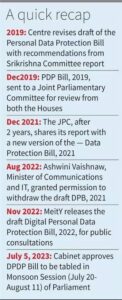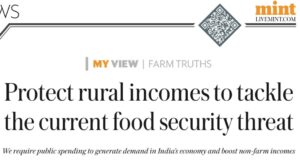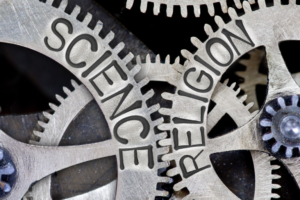Topic 1:Draft Data Protection Bill
GS 2: Important aspects of governance, transparency and accountability, e-governance- applications, models, successes, limitations, and potential; citizens charters, transparency & accountability and institutional and other measures.
GS 3 : Awareness in the fields of IT, Space, Computers, robotics, Nano-technology, bio-technology and issues relating to intellectual property rights.

Introduction:

- The Union Cabinet has approved the draft Data Protection Bill, which is now set for debate and approval in Parliament.
- This bill is expected to lay the foundation for digitalization and data initiatives by both the government and private sector.
- However, an analysis reveals that the draft bill fails to adequately address the public concerns that led to the Supreme Court recognizing privacy as a fundamental right.
Insufficient Focus on Data Protection:
- The central objective of the draft bill seems to be facilitating data collection and processing, rather than prioritizing data protection.
- The Supreme Court emphasized the importance of informational self-determination and control as crucial aspects for privacy protection, but the bill appears to overlook these concerns.
Lack of Legal Framework:
The requirement of legality, as established by the Supreme Court, suggests the need for enabling laws as prerequisites for digital applications, including digital surveillance.

- However, Section 5 of the draft bill implies that any purpose not expressly forbidden by law would be allowed, contradicting the principle of legality.
Neglecting Legitimacy and Proportionality:
- Legitimacy necessitates the establishment of a legitimate interest behind proposed digitalization, while proportionality requires the least intrusive digital applications and a balance of fundamental rights.
- However, the draft bill lacks clear standards for both legitimacy and proportionality, leaving these tests vague and unclear.
Inadequate Measures for Privacy Protection:
- The draft bill fails to consider the nuances of privacy risks arising from digital applications.
The indirect harms resulting from invasions that link siloed data items are difficult to detect but have long-term consequences.

- The post-violation complaints and penalties outlined in the bill are insufficient for addressing and mitigating these risks, highlighting the need for ex-ante privacy protection measures.
Over-Reliance on Consent:
- The draft bill heavily relies on consent, placing the burden on individuals to understand complex privacy risks.
- However, consent often presents a false choice and may unreasonably limit options or impede freedom of expression.
- An effective data protection framework should focus on accountability rather than consent, holding data controllers and fiduciaries responsible.
Lack of Focus on Technical Considerations:
- The draft bill remains silent on crucial technical aspects such as anonymization, encryption, and access control.
- These considerations are vital for comprehensive data protection and should be addressed in the bill or associated regulations.
Failure to Address Fairness, Bias, and Misinformation:
- The draft bill overlooks concerns related to fairness, bias, and misinformation arising from automated data processing, particularly in AI applications.
- An effective data protection bill should take these issues into account to ensure comprehensive protection.
Conclusion:
The current draft Data Protection Bill falls short in several respects, revealing a mindset focused on enabling digitalization rather than understanding and addressing privacy concerns.
The bill lacks a sufficient emphasis on data protection, a legal framework, legitimacy, proportionality, and technical considerations. Additionally, it neglects fairness, bias, and misinformation concerns.
It is essential for the draft bill to undergo significant revisions to address these shortcomings and ensure robust privacy protection in the digital age.
Topic 2 : Protecting rural incomes to tackle the current food security threat
GS 3: Issues related to direct and indirect farm subsidies and minimum support prices; Public Distribution System-objectives, functioning, limitations, revamping; issues of buffer stocks and food security

Introduction
- The recent release of retail inflation data by the National Statistical Office has shown a moderate rise in inflation to 4.81% in June, within India’s tolerance band.
- However, the increase in food inflation, particularly in the foodgrain group, is a significant concern for the government.
Food Inflation on the Rise:
- Food inflation has climbed to 49% from 2.96%, posing a challenge for the government.
- The foodgrain group, particularly cereals and pulses, has contributed the most to this increase.
- Cereal inflation is at 13%, with both rice and wheat showing 12% inflation.
- The dominant pulse item, arhar (tur), has reached 27% inflation.
Wheat Inflation:
- Inflation in wheat has been in double digits for over a year, indicating price pressures building up.
- Market estimates suggest that wheat production this year may be lower than the government’s estimate of 7 million tonnes.
- The government’s inability to procure the target amount of wheat confirms concerns about lower supply.
Rice Concerns:
- While the government holds sufficient rice stocks, the uncertain monsoon season is a cause for worry.
- Excess rainfall in north-west India has resulted in an above-normal monsoon there, but the southern peninsula and eastern region face deficits.
- This disparity may affect rice crops, and lower output is anticipated due to deficient rains.
Challenges with Pulses and Oilseeds:
- Sowing of pulses, especially arhar, is lower by almost 10% this year.
- Similarly, oilseeds sowing, including soybean, has decreased by more than 10%.
- Weather conditions pose challenges, and inflationary pressures in foodgrains are likely to remain high.
Spillover Effects and Income Protection:
- Inflation in foodgrains is expected to impact other food items, such as milk, due to rising fodder costs.
- Milk inflation remains high at 9% in June.
- The disproportionate weight of these items in the consumption basket will squeeze demand for other commodities.
- Lower output from floods and deficient monsoon rains necessitates proactive measures to protect farmer incomes.
Protecting Rural Economy:
- The distress in rural areas continues to be a challenge, with stagnant real wages and declining income from other sources.
- While government stocks are sufficient for the Public Distribution System (PDS), open market operations are limited.
- Food security interventions through the PDS can help cushion the impact.
- However, a broader strategy is needed to protect the rural economy, including increased public spending to generate demand, raise incomes, and create non-farm employment.
Conclusion:
The rise in food inflation, particularly in foodgrains, poses challenges for the government. With concerns over wheat and rice production, as well as lower sowing of pulses and oilseeds, inflationary pressures are likely to persist.
The government must take proactive measures to protect farmers’ incomes and implement strategies to raise incomes for the poor.
Ensuring food security goes beyond providing foodgrains; it involves raising the income levels of the vulnerable population and promoting a diversified and nutritious consumption basket.
Topic 3 :Science vs Religion

Syllabus Relevance for the topic
GS 1: Salient features of Indian Society, Diversity of India.
GS 1: Social empowerment, communalism, regionalism & secularism.
GS 3: Science and Technology- developments and their applications and effects in everyday life.
Anthropology : Religion: Anthropological approaches to the study of religion (evolutionary, psychological and functional)
Sociology : Religion and Society – Religion in modern society: religion and science, secularization, religious revivalism, fundamentalism.
Introduction:
- The debate surrounding the compatibility of science and religion has been a long-standing topic of discussion.
- While some argue for a harmonious relationship between the two, others assert their inherent incompatibility.
Science and Religion as Separate Domains:
- According to the Stanford Encyclopedia of Philosophy, science and religion operate within distinct realms.
- Science focuses on natural phenomena and employs empirical inquiry, while religion deals with the supernatural and relies on faith.
- Their methodologies and explanations differ significantly, making them fundamentally irreconcilable.
Historical Tensions and Misuse of Religion:
- Throughout history, religion has been associated with numerous instances of conflict and suffering.
- The assertion of religious certainty, often divorced from reason and observation, has led to violence and oppression.
- Instances such as the persecution of heretics and the imposition of religious laws demonstrate the dangers of intertwining religion with other domains.
Spirituality and Science:
- Although spirituality and religion are often linked, spirituality can exist independently of religious frameworks.
- Scientists like Carl Sagan argue that the study of the natural world and the universe can evoke a profound sense of spirituality and humility.
- Recognizing our insignificance within the vast cosmos can foster a spiritual connection without necessitating religious beliefs.
Attempts at Integration:
- Efforts have been made to bridge the gap between science and religion.
- Some proposed unifying knowledge systems, seeking to incorporate science, morality, ethics, and religion.
- However, such endeavors have often resulted in confusion and controversy, lacking a coherent and universally accepted framework.
The Intelligent Design Debate:
- The concept of intelligent design, proposed as an alternative to evolutionary theory, attempts to reconcile science and religion.
- However, the conflict arises when intelligent design contradicts scientific explanations such as quantum electrodynamics and biological evolution.
- The integration of faith and ancient wisdom into scientific theories has not gained consensus and is often viewed as pseudoscience.
Subjectivity, Faith, and Surrender:
- Religion thrives on subjective experiences, often requiring blind faith and surrender.
- It offers solace and promises of eternal deliverance, appealing to human desires for comfort and purpose.
- The subjective nature of religious experiences can overshadow objective evidence, making it challenging to approach reality with objectivity.
Conclusion:
Science relies on empirical inquiry and natural explanations, while religion operates within the realm of faith and the supernatural.
Attempts to merge the two have led to confusion and conflicts.
However, discussions surrounding this topic often extend beyond the scientific and religious domains, touching upon political, social, and philosophical dimensions.
Rationality and logic can become casualties in these debates, leaving the pursuit of objective truth at risk.

